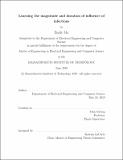| dc.contributor.advisor | John Guttag. | en_US |
| dc.contributor.author | Mu, Emily,M. Eng.Massachusetts Institute of Technology. | en_US |
| dc.contributor.other | Massachusetts Institute of Technology. Department of Electrical Engineering and Computer Science. | en_US |
| dc.date.accessioned | 2019-11-22T00:04:11Z | |
| dc.date.available | 2019-11-22T00:04:11Z | |
| dc.date.copyright | 2019 | en_US |
| dc.date.issued | 2019 | en_US |
| dc.identifier.uri | https://hdl.handle.net/1721.1/123046 | |
| dc.description | This electronic version was submitted by the student author. The certified thesis is available in the Institute Archives and Special Collections. | en_US |
| dc.description | Thesis: M. Eng., Massachusetts Institute of Technology, Department of Electrical Engineering and Computer Science, 2019 | en_US |
| dc.description | Cataloged from student-submitted PDF version of thesis. | en_US |
| dc.description | Includes bibliographical references (pages 57-60). | en_US |
| dc.description.abstract | Clostridioides difficile infections (CDIs) impose a substantial burden on the healthcare system leading to poor health out comes, mortality and costs to the heath-care system estimated at greater than $5 billion. One of the reasons why CDIs are hard to control is the contribution of individual infections to the risk of transmission is not well understood. In this paper, we propose modeling incident infections using a Hawkes process, which is a self-exciting stochastic process, encoding the intuition that new infections trigger further infections. Using data from a large urban hospital, we demonstrate that our approach reveals different patterns of infection spread across patient care units. These insights can be used to guide unit-specific interventions aimed at interrupting transmission. | en_US |
| dc.description.statementofresponsibility | by Emily Mu. | en_US |
| dc.format.extent | 60 pages | en_US |
| dc.language.iso | eng | en_US |
| dc.publisher | Massachusetts Institute of Technology | en_US |
| dc.rights | MIT theses are protected by copyright. They may be viewed, downloaded, or printed from this source but further reproduction or distribution in any format is prohibited without written permission. | en_US |
| dc.rights.uri | http://dspace.mit.edu/handle/1721.1/7582 | en_US |
| dc.subject | Electrical Engineering and Computer Science. | en_US |
| dc.title | Learning the magnitude and duration of influence of infections | en_US |
| dc.type | Thesis | en_US |
| dc.description.degree | M. Eng. | en_US |
| dc.contributor.department | Massachusetts Institute of Technology. Department of Electrical Engineering and Computer Science | en_US |
| dc.identifier.oclc | 1127911615 | en_US |
| dc.description.collection | M.Eng. Massachusetts Institute of Technology, Department of Electrical Engineering and Computer Science | en_US |
| dspace.imported | 2019-11-22T00:04:09Z | en_US |
| mit.thesis.degree | Master | en_US |
| mit.thesis.department | EECS | en_US |
